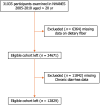Relationship between dietary fiber intake and chronic diarrhea in adults
- PMID: 38994290
- PMCID: PMC11235452
- DOI: 10.12998/wjcc.v12.i19.3692
Relationship between dietary fiber intake and chronic diarrhea in adults
Abstract
Background: Dietary fiber is essential for human health and can help reduce the symptoms of constipation. However, the relationship between dietary fiber and diarrhea is, poorly understood.
Aim: To evaluate the relationship between dietary fiber and chronic diarrhea.
Methods: This retrospective study was conducted using data from the United States National Health and Nutrition Examination Survey, conducted between 2005 and 2010. Participants over the age of 20 were included. To measure dietary fiber consumption, two 24-hour meal recall interviews were conducted. The independent relationship between the total amount of dietary fiber and chronic diarrhea was evaluated with multiple logistic regression and interaction analysis.
Results: Data from 12829 participants were analyzed. Participants without chronic diarrhea consumed more dietary fiber than participants with chronic diarrhea (29.7 vs 28.5, P = 0.004). Additionally, in participants with chronic diarrhea, a correlation between sex and dietary fiber intake was present: Women who consume more than 25 g of dietary fiber daily can reduce the occurrence of chronic diarrhea.
Conclusion: Dietary fiber can reduce the occurrence of chronic diarrhea.
Keywords: Chronic diarrhea; Fiber; National Health and Nutrition Examination Survey; Prebiotics; Sex.
©The Author(s) 2024. Published by Baishideng Publishing Group Inc. All rights reserved.
Conflict of interest statement
Conflict-of-interest statement: The authors declare no conflict of interest.
Figures
Similar articles
-
Association Between Selenium Intake with Chronic Constipation and Chronic Diarrhea in Adults: Findings from the National Health and Nutrition Examination Survey.Biol Trace Elem Res. 2021 Sep;199(9):3205-3212. doi: 10.1007/s12011-020-02451-x. Epub 2020 Oct 23. Biol Trace Elem Res. 2021. PMID: 33095434
-
Effect of Physical Activity on the Association Between Dietary Fiber and Constipation: Evidence From the National Health and Nutrition Examination Survey 2005-2010.J Neurogastroenterol Motil. 2021 Jan 30;27(1):97-107. doi: 10.5056/jnm20051. J Neurogastroenterol Motil. 2021. PMID: 33380555 Free PMC article.
-
The Association of Dietary Fiber Intake in Three Meals with All-Cause and Disease-Specific Mortality among Adults: The U.S. National Health and Nutrition Examination Survey, 2003-2014.Nutrients. 2022 Jun 17;14(12):2521. doi: 10.3390/nu14122521. Nutrients. 2022. PMID: 35745250 Free PMC article.
-
Association Between Dietary Fiber Intake and Non-alcoholic Fatty Liver Disease in Adults.Front Nutr. 2020 Nov 19;7:593735. doi: 10.3389/fnut.2020.593735. eCollection 2020. Front Nutr. 2020. PMID: 33330594 Free PMC article.
-
Dietary Fiber Intake is Associated with Cognitive Function in Older Adults: Data from the National Health and Nutrition Examination Survey.Am J Med. 2022 Aug;135(8):e257-e262. doi: 10.1016/j.amjmed.2022.03.022. Epub 2022 Apr 1. Am J Med. 2022. PMID: 35367443
Cited by
-
Nutrition in Inflammatory Bowel Disease: Strategies to Improve Prognosis and New Therapeutic Approaches.Diseases. 2025 May 1;13(5):139. doi: 10.3390/diseases13050139. Diseases. 2025. PMID: 40422571 Free PMC article. Review.
References
-
- Artale S, Grillo N, Lepori S, Butti C, Bovio A, Barzaghi S, Colombo A, Castiglioni E, Barbarini L, Zanlorenzi L, Antonelli P, Caccialanza R, Pedrazzoli P, Moroni M, Basciani S, Azzarello R, Serra F, Trojani A. A Nutritional Approach for the Management of Chemotherapy-Induced Diarrhea in Patients with Colorectal Cancer. Nutrients. 2022;14 - PMC - PubMed
-
- El Kaoutari A, Armougom F, Gordon JI, Raoult D, Henrissat B. The abundance and variety of carbohydrate-active enzymes in the human gut microbiota. Nat Rev Microbiol. 2013;11:497–504. - PubMed
LinkOut - more resources
Full Text Sources



